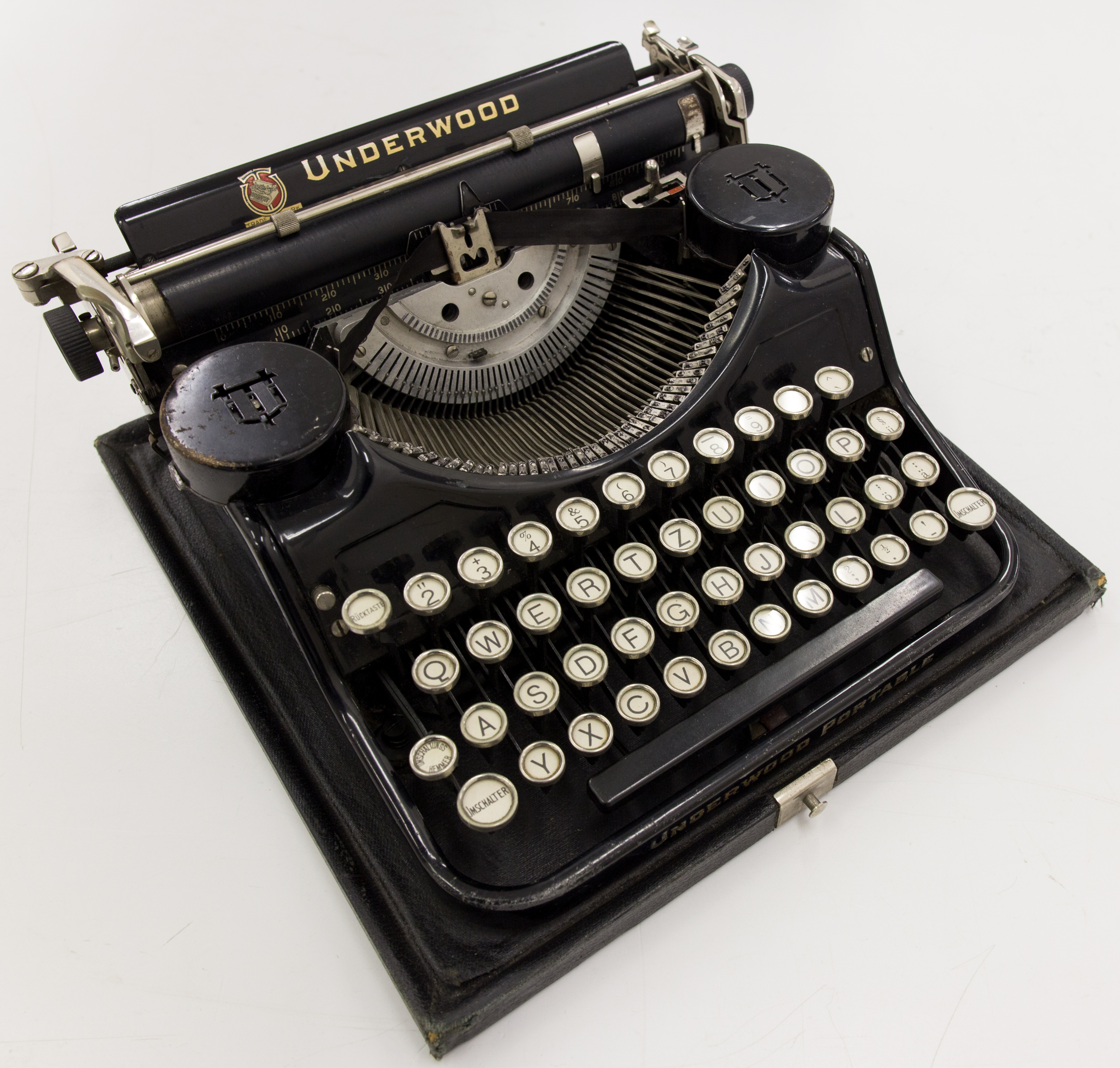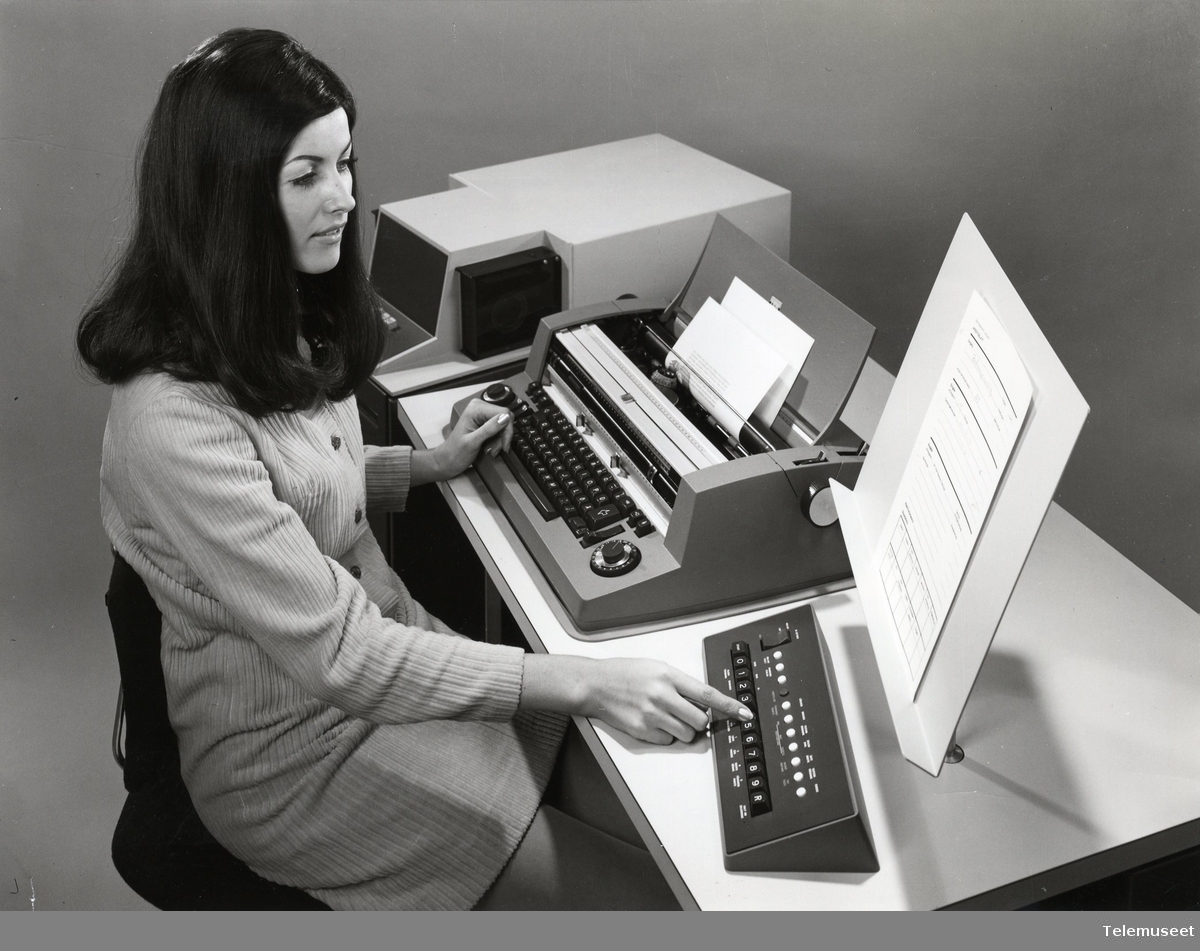|
Selectric
The IBM Selectric (a portmanteau of "selective" and "electric") was a highly successful line of electric typewriters introduced by IBM on 31 July 1961. Instead of the "basket" of individual typebars that swung up to strike the ribbon and page in a typical typewriter of the period, the Selectric had a chrome-plated plastic "element" (frequently called a "typeball", or less formally, a "golf ball") that rotated and tilted to the correct position before striking the paper. The element could be easily interchanged to use different fonts within the same document typed on the same typewriter, resurrecting a capability which had been pioneered by typewriters such as the Hammond and Blickensderfer in the late 19th century. The Selectric also replaced the traditional typewriter's horizontally moving carriage with a roller (platen) that turned to advance the paper vertically while the typeball and ribbon mechanism moved horizontally across the paper. The Selectric mechanism was notable ... [...More Info...] [...Related Items...] OR: [Wikipedia] [Google] [Baidu] |
Electric Typewriter
A typewriter is a Machine, mechanical or electromechanical machine for typing characters. Typically, a typewriter has an array of Button (control), keys, and each one causes a different single character to be produced on paper by striking an ink ribbon, inked ribbon selectively against the paper with a Sort (typesetting), type element. Thereby, the machine produces a legible written document composed of ink and paper. By the end of the 19th century, a ''person'' who used such a device was also referred to as a ''typewriter''. The first commercial typewriters were introduced in 1874, but did not become common in offices in the United States until after the mid-1880s. The typewriter quickly became an indispensable tool for practically all writing other than personal handwritten correspondence. It was widely used by professional writers, in offices, in business correspondence in private homes, and by students preparing written assignments. Typewriters were a standard fixture in m ... [...More Info...] [...Related Items...] OR: [Wikipedia] [Google] [Baidu] |
IBM MT/ST
The IBM MT/ST (Magnetic Tape/Selectric Typewriter, and known in Europe as MT72) is a model of the IBM Selectric typewriter, built into its own desk, integrated with magnetic tape recording and playback facilities, located in an attached enclosure, with controls and a bank of relays. It was released by IBM in 1964. Description The MT/ST records text typed on 1/2" magnetic tape, approximately 25 kilobytes per tape cassette, and allows editing and re-recording during playback. It was the first system marketed as a word processor. Most models have two tape drives, which greatly facilitated revision and enabled features such as mail merge. A module adds a third tape station, to record the combined output of playback from the two stations. The MT/ST automates word wrap, but it has no screen, automated hyphenation (soft hyphens were available), or concept of the page; pages have to be divided and numbered by the human operator during playback. Instruction manuals taught the operator th ... [...More Info...] [...Related Items...] OR: [Wikipedia] [Google] [Baidu] |
IBM 2741
The IBM 2741 is a printing computer terminal that was introduced in 1965. Compared to the teletypewriter machines that were commonly used as printing terminals at the time, the 2741 offers 50% higher speed, much higher quality printing, quieter operation, interchangeable type fonts, and both upper and lower case letters. It was used primarily with the IBM System/360 series of computers, but was used with other IBM and non-IBM systems where its combination of higher speed and letter-quality output was desirable. It was influential in the development and popularity of the APL programming language. It was supplanted, starting in the mid-1970s, primarily by printing terminals using daisy wheel mechanisms. Design The IBM 2741 combines a ruggedized Selectric typewriter mechanism with IBM SLT electronics and an RS-232-C serial interface. It operates at about 14.1 characters per second with a data rate of 134.5 bits/second (one start bit, six data bits, an odd parity bit, and on ... [...More Info...] [...Related Items...] OR: [Wikipedia] [Google] [Baidu] |
Eliot Noyes
Eliot Fette Noyes (August 12, 1910 – July 18, 1977) was an American architect and industrial designer, who worked on projects for IBM, most notably the IBM Selectric typewriter and the Otis College of Art and Design, IBM Aerospace Research Center in Los Angeles, California. Noyes was also a pioneer in development of comprehensive corporate-wide design programs that integrated design strategy and business strategy. Noyes worked on corporate imagery for IBM, Mobil Oil, Cummins Engine and Westinghouse. Early life Eliot Noyes was born in Boston, Massachusetts. Shortly after his birth, Noyes moved to Colorado where he resided until age seven. At this point, Noyes and his family moved to Cambridge, Massachusetts, Cambridge, Massachusetts. Noyes’ father taught English at Harvard University and his mother was an accomplished pianist. He was not always set on architecture. As a teen, he seriously contemplated becoming a painter; however by age 19 he had his mind set on architecture ... [...More Info...] [...Related Items...] OR: [Wikipedia] [Google] [Baidu] |
IBM Electric Typewriter
The IBM Electric were an early series of electric typewriters that IBM manufactured, starting in the mid-1930s. They used the conventional moving carriage and typebar mechanism, as opposed to the fixed carriage and type ball used in the IBM Selectric, introduced in 1961. After 1944, each model came in both "Standard" and "Executive" versions, the latter featuring proportional spacing. History The IBM Electromatic typewriter was the first electric typewriter to enjoy long-term commercial success. Unlike the later IBM Selectric typewriter, this typewriter model used a conventional moving carriage and typebar mechanism. The history of the Electromatic goes back to 1924, when the North East Electric Company received patent rights for the power roller from James Smathers. At that time, the company was selling electric motors, and wanted to get into the typewriter business. They reached an arrangement with Remington, securing a contract for 2,500 machines in 1925. N. E. Electric ma ... [...More Info...] [...Related Items...] OR: [Wikipedia] [Google] [Baidu] |
IBM Wheelwriter
The Wheelwriter is a line of electronic typewriters that was manufactured by International Business Machines Corporation (IBM) from 1984 to 1991 and by Lexmark International (a spin-off of IBM) from 1991 to 2001. Typewriters in the Wheelwriter series use swappable daisy wheel cartridges to produce high-quality letterforms on the page via an ink ribbon and an impact printing head. Cartridges can be swapped out to allow the user to switch between a wide array of typefaces. The Wheelwriter was IBM's first daisy wheel typewriter and represented the technical apex of IBM's typewriter families, replacing their long-lived and commercially successful IBM Selectric typewriter series on its introduction in 1984. Features All models in the Wheelwriter range possess some amount of electronic memory, acting as a data buffer and allowing for a number of advanced features, including algorithmic centering of text on a line, basic spell-checking, and word-by-word erasure of text (either via wh ... [...More Info...] [...Related Items...] OR: [Wikipedia] [Google] [Baidu] |
Blickensderfer Typewriter
The Blickensderfer typewriter was invented by George Canfield Blickensderfer (1850–1917) and patented on April 12, 1892. Blickensderfer was a nephew of John Celivergos Zachos, the inventor of the stenotype. Two models, Model 1 and Model 5, were unveiled to the public at the 1893 World's Columbian Exposition in Chicago. The Model 5 was a stripped-down version of the bigger, more complex Model 1. These machines were intended to compete with larger Remington, Hammond and Yost typewriters, and were the first truly portable, full-keyboard typewriters. The design also enabled the typist to see the typed work, at a time when most typewriters were understrike machines that concealed the writing. When Blickensderfer unveiled his small Model 5, its compactness and novel features attracted huge crowds and many orders. History The Blickensderfer typewriters were initially manufactured in a rented factory on Garden Street in Stamford, Connecticut. By 1896, due to strong foreign deman ... [...More Info...] [...Related Items...] OR: [Wikipedia] [Google] [Baidu] |
Digital-to-analog Converter
In electronics, a digital-to-analog converter (DAC, D/A, D2A, or D-to-A) is a system that converts a digital signal into an analog signal. An analog-to-digital converter (ADC) performs the reverse function. DACs are commonly used in music players to convert digital data streams into analog audio signals. They are also used in televisions and mobile phones to convert digital video data into analog video signals. These two applications use DACs at opposite ends of the frequency/resolution trade-off. The audio DAC is a low-frequency, high-resolution type while the video DAC is a high-frequency low- to medium-resolution type. There are several DAC architectures; the suitability of a DAC for a particular application is determined by figures of merit including: resolution, maximum sampling frequency and others. Digital-to-analog conversion can degrade a signal, so a DAC should be specified that has insignificant errors in terms of the application. Due to the complexity ... [...More Info...] [...Related Items...] OR: [Wikipedia] [Google] [Baidu] |
IBM MT/SC
International Business Machines Corporation (using the trademark IBM), nicknamed Big Blue, is an American multinational technology company headquartered in Armonk, New York, and present in over 175 countries. It is a publicly traded company and one of the 30 companies in the Dow Jones Industrial Average. IBM is the largest industrial research organization in the world, with 19 research facilities across a dozen countries; for 29 consecutive years, from 1993 to 2021, it held the record for most annual U.S. patents generated by a business. IBM was founded in 1911 as the Computing-Tabulating-Recording Company (CTR), a holding company of manufacturers of record-keeping and measuring systems. It was renamed "International Business Machines" in 1924 and soon became the leading manufacturer of punch-card tabulating systems. During the 1960s and 1970s, the IBM mainframe, exemplified by the System/360 and its successors, was the world's dominant computing platform, with the company p ... [...More Info...] [...Related Items...] OR: [Wikipedia] [Google] [Baidu] |







